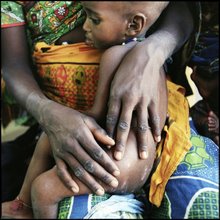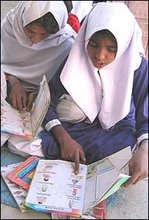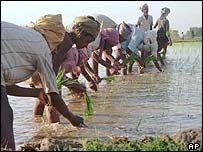PREAMBLE: During our first 6 months, this report addressed the following global issues: climate change, child development, colonized minorities, food security, human rights, and other news and reviews. In most instances we also addressed the relevance of these issues to Canada, our home base. To locate these issues you may either scan down this issue to earlier issues, or Google search by combining the keywords just noted with the term pacificsci.
This June 2007 issue reviews the vexing issue of official development assistance from wealthy developed countries such as Canada, makes reference to a report on global social and economic trends, then selects reports from a discipline that is essential to understanding global health trends: Health Situation Analysis. This refers to information on health conditions, supported by vital and health statistics critical to strategic and operational development planning. Our selected examples include Africa, the State of the World Children, and Projections of Mortality and Burden of Disease to 2030.
Our sidebar addresses the emergence of “corporate hybrids”, freedom of speech and tolerance for intellectual opinions.
G7 OFFICIAL DEVELOPMENT ASSISTANCE (ODA)
The most recent confirmed OECD data for ODA (2005) reveal that, although absolute amounts are higher, G7 countries allocate proportionally less Gross National Income (GNI) for international development: 0.30%, compared with .50% for non-G7 nations. Of 22 OECD nations only 5 met the UN target of at least 0.7%: Norway, Sweden, Denmark, the Netherlands, and Luxembourg, none of which are G7 countries. The lowest G7 allocation is made by the USA (0.22%; among 15 non- G7 nations, only Portugal and Greece give less than this), while Canada comes in slightly above the G7 mean at 0.34%. Clearly, both individually and collectively, the G7 should show more leadership.
Note: OECD rankings do not include Russia, a G8 country (G7 + 1).
Reference: Final ODA Data for 2005. http://www.oecd.org/dataoecd/52/18/37790990.pdf
SERIOUS QUESTIONS ABOUT CANADA’s ODA
Questions are being raised about Canada’s ODA priorities eg., $30 million in 2006 to China, an emerging political and economic powerhouse. Parliamentarians urging increased aid to truly poor nations say the government’s refusal to support proposed new legislation to guide ODA reveals lack of commitment. “Canada used to be a leader and is now a… laggard” said Alexa McDonough, NDP foreign affairs critic. According to McDonough, the planned 2006 ODA of just over $3 billion represents 0.32 % of GNI, down from 0.34% last year and far off the 0.7% target that Canada helped set. Josee Verner, Minister for international aid, replied “spending in 2007-08 will increase by 8%, in line with the goal of doubling by 2011 the amount spent on ODA in 2001”.
Source: Sue Bailey. The Canadian Press. March 27, 2007
EDITORIAL: an annual increase in absolute expenditures in the order of 8% will simply maintain the status quo with little movement towards the target of 0.7% GNI
REPORT FROM 8TH GLOBAL DEVELOPMENT CONFERENCE, Beijing. For up-to-date social and economic trends, visit the Global Development Network April 2007 newsletter. Topics include: the rise of Asia in the global economy; growth and poverty in Latin America; structural transformation opportunities in Africa and the Middle East. http://www.gdnet.org/pdf2/research_monitor/2007-April_conference%20edition_Research%20Monitor.pdf
HEALTH SITUATION OF SUB-SAHARAN AFRICA
The health situation of Sub-Saharan Africa (SSA) is the least favourable of all regions. Following steady declines until the mid-1990s, adult mortality sharply reversed, with the disease burden increasingly dominated by HIV/AIDS superimposed on already heavy burdens from endemic malaria, water-borne diseases, vaccine-preventable diseases, nutritional deficiencies, and other preventable conditions. In some settings, this was compounded by war and civil strife, with consequent increases in violent death, food shortages, poverty and displacement of people, further fueling a rural to urban migration for economic survival. In parts of SSA, adult mortality rates are at their highest in 3 decades; a rapid drop in life expectancy (LE) is seen in 38 countries (LE age 40 or less in 8 of these). Without HIV/AIDS, LE at birth would have been almost 6.1 years higher in 2002. The slippage is not only due to HIV/AIDS: for example, despite major gains in immunization coverage during the 1980s, these have reversed since, reflecting a loss of capacity to deliver primary health care. In the meantime, the health profiles of Africa and the world are not standing still: the pattern is shifting with a steady increase in Non-Communicable Diseases and injuries. Even given Africa’s preoccupation with infectious diseases, which still dominate the disease burden, planners must now be alert to this emerging and future disease burden.
Source: The foregoing brief report is a paraphrased extract from a health situation analysis carried out by PacificSci for an assignment in East Africa completed in 2006.
THE HEALTH OF THE PEOPLE: THE AFRICAN REGIONAL HEALTH REPORT: A fully comprehensive situation analysis has recently been published by the WHO Regional Office for Africa. http://www.who.int/bulletin/africanhealth/en/index.html
THE STATE OF THE WORLD’s CHILDREN 2007
This UNICEF report focuses on the discrimination and disempowerment experienced by women and girls. It discusses how gender equality will move the UN Millennium Development Goals forward, and how investment in women’s rights will ultimately produce a dual dividend: advancing the rights of women and children. Seven interventions are advocated:
1. Abolish school fees and invest in girls' education
2. Invest government funding in gender equality
3. Enact legislation to create a level playing field for women and to address domestic as well as gender-based violence
4. Ensure women's participation in politics
5. Involve women's grassroots organizations in policy development
6. Engage men and boys on the importance of gender equality
7. Improve research and data on gender issues.
For the full report as a PDF document: http://www.unicef.org/sowc07/report/report.php
PROJECTIONS OF MORTALITY & DISEASE BURDEN TO 2030
Revised global and regional projections of mortality and burden of disease by cause for 2005, 2015 and 2030 are now available from the World Health Organization. Principal investigators (CD Mathers & D Loncar) applied separate projection models for males and females, stratified into 7 age groups. The website below offers online access to the article, a working paper, and references to papers on data sources and methods. Detailed results for projected deaths and DALYs can be downloaded as Excel spreadsheets. The analyses were carried out at country level with aggregation into regional or income groups. The investigators used socio-economic projections to model future mortality and morbidity patterns, assuming slower and faster rates of development and population growth, taking into account independent variables: income, education, time, and tobacco use. The results suggest that, from 2002 to 2030, life expectancy will increase throughout the world, with an upward shift in the age of deaths, with considerably fewer younger children dying, while deaths due to cancer and heart disease will increase. Deaths from infectious diseases will decline overall, while mortality from HIV/AIDS will continue to increase. http://www.who.int/healthinfo/statistics/bodprojections2030/en/index.html
Acknowledgment: In constructing our summary, a review by Robert Goldberg on ProCOR (Recommended link in sidebar) was helpful, including his note of caution regarding the quality of data used to develop the predictive models and assumptions utilized.
THANKS FOR VISITING PacificSci GLOBAL PERSPECTIVES!


























